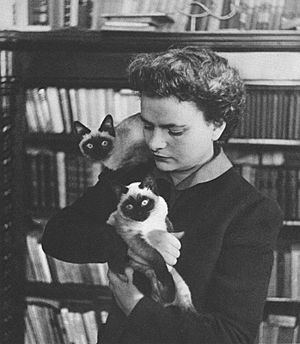Elsa Morante facts for kids
Quick facts for kids
Elsa Morante
|
|
|---|---|
 |
|
| Born | 18 August 1912 Rome, Italy |
| Died | 25 November 1985 (aged 73) Rome, Italy |
| Occupation | Novelist |
| Notable works | La storia (History) |
| Notable awards | Viareggio Prize (1948) Strega Prize (1957) |
| Spouse | |
Elsa Morante (born August 18, 1912 – died November 25, 1985) was a famous Italian writer. She wrote novels, poems, and even books for children. Her novel La storia (which means History) is considered one of the 100 best books of all time.
Contents
Elsa Morante's Life and Career
Elsa Morante was born in Rome, Italy, in 1912. Her mother was a teacher. Elsa found out later that a family friend was her biological father. She lived in Rome for most of her life. The only time she left was for a short period during World War II.
Starting Her Writing Journey
Elsa began writing when she was very young. She mostly taught herself because her parents didn't give her much help. In the mid-1930s, she started writing short stories. Some of these stories were printed in magazines, including some for children.
Her first book, a collection of short stories called Il Gioco Segreto (The Secret Game), came out in 1941. That same year, she married another writer and film critic named Alberto Moravia. In 1942, she wrote her first children's book. It was called Le Bellissime avventure di Caterì dalla Trecciolina. This book was later republished with a new title.
Wartime Experiences and New Books
During World War II, German soldiers took control of Italy. Elsa and her husband, Alberto, were worried because of their Jewish family background. They left Rome and hid in a small village in Southern Lazio. This village was home to many poor shepherd families.
Their experiences during the war inspired both Elsa and Alberto to write important novels. Elsa's book, La storia (1974), and Alberto's book, La Ciociara (which means Two Women), came from this time. While living there, Elsa also started translating books by the writer Katherine Mansfield. Elsa even risked her life to go back to war-torn Rome. She wanted to get the manuscript for her first novel and some warm clothes.
Success and Later Works
After the war, Elsa and Alberto met an American translator named William Weaver. He helped them share their books with English-speaking readers. Elsa's first novel, Menzogna e sortilegio (House of Liars), was published in 1948. It won the Viareggio Prize, a big award in Italy. Even though it was successful internationally, Elsa was not happy with the English translation.
Her next novel, L'isola di Arturo (Arturo's Island), came out in 1957. This book won the Strega Prize, another very important Italian literary award. In 1961, Elsa and Alberto separated. After this, Elsa wrote less often. She even destroyed many of the things she wrote during that time. However, she did publish a novel called The Andalusian Shawl (1963) and a poem called The Adventure.
In 1968, she published Il mondo salvato dai ragazzini (The World Saved by Children). This book was a mix of poetry and songs. In 1963, the famous director Pier Paolo Pasolini asked Elsa to choose the music for his film The Gospel According to St. Matthew. She also helped choose the actors for the movie.
La storia and Final Novel
In 1974, Elsa published La storia. This book told the story of events in Rome during World War II. It became a huge bestseller in Italy. Elsa made sure her publisher released it as an affordable paperback. This meant many people could buy and read it.
However, some literary critics did not like the book. They felt it went against their political ideas. After Pier Paolo Pasolini wrote a negative review, Elsa ended their friendship. La storia was later made into a TV series in 1986.
Elsa's last novel was Aracoeli, published in 1982. This book brought together many of the ideas she wrote about throughout her career. These ideas included the innocence of childhood and how important it is to imagine fantastic worlds to escape from sad realities.
Major Themes in Elsa Morante's Books
Elsa Morante loved music, books, and cats. Some of her favorite books were The Iliad, Don Quixote, and Hamlet. She was also interested in ideas from thinkers like Plato. The beautiful landscapes of Southern Italy often appeared in her stories.
Childhood and Imagination
Many of Elsa's greatest works were shaped by her own life and experiences. These experiences are often reflected in her main characters. A key idea in her writing is the importance of childhood. She believed in the power of imagination. Her characters often create wonderful, imaginary worlds. These worlds help them escape from difficult or boring real-life situations.
Understanding Oneself
Another important theme in Elsa's work is characters trying to understand themselves. Many of her main characters use their own life stories to explore their feelings and find hope. Telling their stories becomes a way for them to heal and understand their past. This helps them form a more positive view of their own memories.
See also
 In Spanish: Elsa Morante para niños
In Spanish: Elsa Morante para niños

